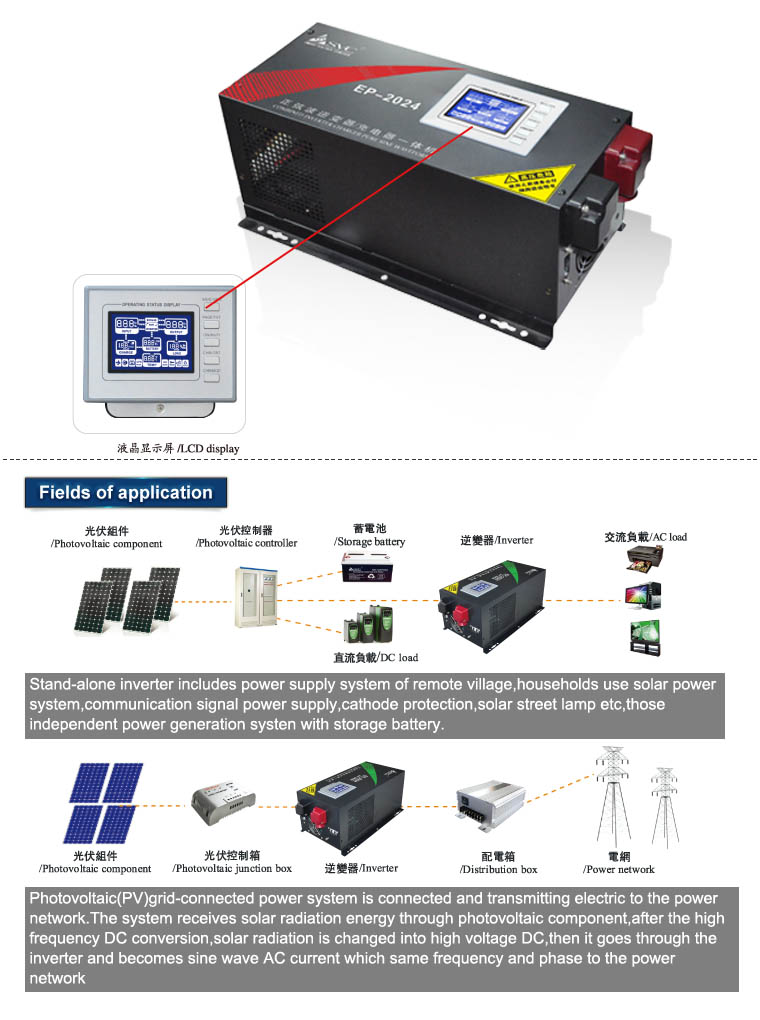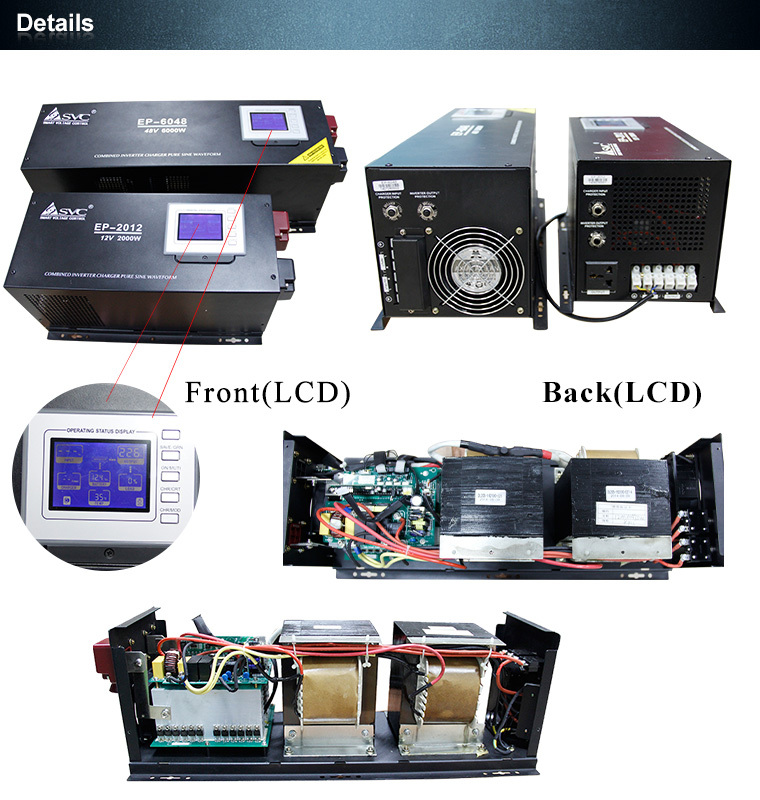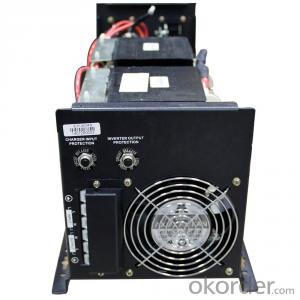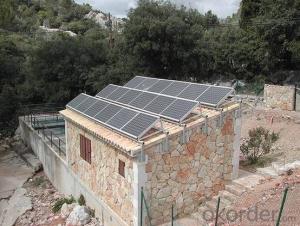Low Frequency Inverter Pure Sine Wave (Remote Control) 1000W 12V 220V Inverter
- Loading Port:
- China main port
- Payment Terms:
- TT OR LC
- Min Order Qty:
- 20 carton
- Supply Capability:
- 10000 carton/month
OKorder Service Pledge
OKorder Financial Service
You Might Also Like
Remote Control Low Frequency Pure Sine Wave 1000W 12V 220V Inverter

Product Description

| Model | EP-1012 | EP-2024 | EP-3024 | EP-4048 | EP-6048 |
| Rated power | 1000W | 2000W | 3000W | 4000W | 6000W |
| INPUT | |||||
| Input voltage range | 185~265VAC | ||||
| OUTPUT | |||||
| Input voltage range | 220VAC/230VAC | ||||
| Output frequency | Batt. Mode:50±0.5Hz Acmode:48~54Hz(50Hz) or 58~64Hz, Same as AC | ||||
| Output wave form | Sine wave (Batt. mode) | ||||
| Transfer time | 10ms(Typical) | ||||
| PROTECTION | |||||
| Overload protection | (100%<Load<120%)±10%:Auto shutdown in 2 mins;(120%<Load<140±10%;Auto shutdown in 60 Secs;(140%<Load)±10%:Auto shutdown in 20 Secs; | ||||
| Output short circuit protection | Yes | ||||
| Breaker | Input:15A/Output:10A | Input:30A / Output:15A | Input:35A / Output:20A | Input:40A / Output:30A | |
| BATTERY | |||||
| Rating charging current(Max.) | 45A | ||||
| Nominal DC input voltage | 12V | 24V | 48V | ||
| 20V/40V | |||||
| PHYSITAL | |||||
| (kg) / Net weight (kg) | 22.8 | 27.6 | 32.4 | 38.2 | 44.5 |
| (mm) / Unit dimention (mm) | 468(L)*224(W)*212(H)mm | 644(L)*224(W)*212(H)mm | |||
| ENVIRONMENT | |||||
| Environment of performance | Temperature 0℃~40℃, Humidity 20%~90% | ||||

Ep series is sine wave low frequency inverter, which is specifically designed for home appliances. It is equipped with a big LCD screen so all information is displayed in detail, which makes it more convenient to use. Charging current of the inverter is adjustable from 5A to 45A and you can also select different charging voltage to charge different types of batteries so batteries are under great protection.
Feature:
1. Suitable for all electrical equipments
2. Large LCD display for more detailed content
3. CPU controlled; fast transfer time
4. Intelligent battery management, prolonging the service life of the battery
5. Complete protection function, high reliability
6. Can provide high current charge
7. Can match different types of batteries
8. Disassembled LCD box which can make the operation in a distance of 15 meters

- Q:Can solar energy systems be used in powering shopping malls or retail centers?
- Yes, solar energy systems can definitely be used to power shopping malls or retail centers. Solar power has become increasingly popular and cost-effective in recent years, making it a viable option for commercial establishments. Large rooftops and parking lots of shopping malls provide ample space for installing solar panels, which can generate a significant amount of electricity to meet the energy needs of these facilities. Solar energy systems can help shopping malls and retail centers reduce their dependence on the grid and lower their energy costs in the long run. By utilizing solar power, these establishments can save on electricity bills and allocate those savings towards other operational expenses or improvements. Moreover, installing solar panels in shopping malls and retail centers can also enhance their sustainability and environmental credentials. As renewable energy sources, solar systems produce clean electricity without emitting greenhouse gases or pollutants. By transitioning to solar power, these establishments can significantly reduce their carbon footprint and contribute positively to the fight against climate change. Furthermore, solar panels can act as a visible demonstration of a mall's commitment to sustainability, which can attract environmentally conscious customers who prioritize shopping at eco-friendly establishments. This can potentially boost foot traffic and revenue for these retail centers. In conclusion, solar energy systems can certainly be used to power shopping malls and retail centers. By harnessing the power of the sun, these establishments can reduce their energy costs, improve their environmental sustainability, and attract customers who value eco-friendly shopping experiences.
- Q:Is it possible to store excess electricity generated by a solar energy system?
- Yes, it is possible to store excess electricity generated by a solar energy system. This can be achieved through the use of batteries or other energy storage systems.
- Q:Can solar energy systems be used in areas with high levels of dust or sandstorms?
- Yes, solar energy systems can be used in areas with high levels of dust or sandstorms. While dust and sandstorms can temporarily reduce the efficiency of solar panels by blocking sunlight, there are several measures that can be taken to mitigate their impact. Firstly, regular cleaning and maintenance of solar panels can help to remove accumulated dust and debris, ensuring maximum sunlight absorption. This can be done manually or through automated cleaning systems that use water or brushes to keep the panels clean. Secondly, advanced panel designs and coatings are available that can minimize the adhesion of dust particles and facilitate easy cleaning. These technologies can help panels to self-clean or reduce the accumulation of dust, ensuring optimal performance even in dusty environments. Additionally, proper installation and positioning of solar panels can also play a significant role in reducing the impact of dust or sandstorms. By tilting the panels at an appropriate angle and maintaining a sufficient ground clearance, the accumulation of dust can be minimized. Furthermore, the use of protective measures such as fences, windbreakers, or enclosures around the solar energy systems can help shield the panels from strong winds and blowing sand during sandstorms. These measures can help prevent physical damage to the panels and maintain their functionality. In conclusion, while dust or sandstorms can pose temporary challenges to solar energy systems, with proper maintenance, cleaning, panel design, positioning, and protective measures, solar energy can still be effectively harnessed in areas with high levels of dust or sandstorms.
- Q:How do solar energy systems impact energy policy and regulation?
- Solar energy systems have a significant impact on energy policy and regulation by promoting the adoption of renewable energy sources and reducing dependence on fossil fuels. Governments and regulatory bodies often implement policies and regulations that incentivize the installation and use of solar energy systems, such as feed-in tariffs or tax credits. This helps to accelerate the transition to clean energy and achieve sustainability goals. Additionally, solar energy systems can influence the development of grid infrastructure and energy storage technologies to accommodate the intermittent nature of solar power, leading to a more resilient and decentralized energy system.
- Q:Can a solar energy system be installed on a boat or RV?
- Yes, a solar energy system can be installed on a boat or RV. In fact, it is becoming increasingly popular to use solar power as a sustainable and efficient source of energy for these types of mobile applications. Solar panels can be mounted on the roof or deck of a boat or RV to capture sunlight and convert it into usable electricity. This allows for greater energy independence and the ability to power various appliances, lighting, and charging devices while on the go.
- Q:How do solar energy systems contribute to reducing peak demand on the electrical grid?
- Solar energy systems contribute to reducing peak demand on the electrical grid by generating electricity during the day, when demand is typically highest. This reduces the reliance on conventional power sources during peak times, thus alleviating strain on the grid and potentially avoiding blackouts or brownouts. Additionally, excess solar energy generated during the day can be stored in batteries or fed back into the grid, further reducing peak demand and providing a more stable and sustainable energy supply.
- Q:Can solar energy systems be used in areas with limited access to distribution networks?
- Yes, solar energy systems can be used in areas with limited access to distribution networks. Off-grid solar systems, also known as standalone systems, can be installed in remote areas without access to traditional electricity grids. These systems generate and store electricity through solar panels and batteries, enabling users to have a reliable and sustainable source of power even without being connected to distribution networks. Off-grid solar energy systems have proven to be an effective solution for providing electricity to communities in remote locations, thus helping to bridge the energy access gap.
- Q:Can solar energy systems be used in remote areas without access to the grid?
- Yes, solar energy systems can be used in remote areas without access to the grid. Solar panels can generate electricity by harnessing sunlight, which can then be stored in batteries for use when the sun is not available. This makes solar energy systems a reliable and sustainable solution for powering remote areas that are off the grid.
- Q:Can a solar energy system be installed in areas with frequent lightning strikes?
- It is indeed possible to install a solar energy system in areas prone to frequent lightning strikes, but certain precautions must be taken to ensure its safety. Failure to do so could result in potential damage to solar panels, inverters, and other system components. To reduce the risk, several strategies can be implemented. The installation of a lightning protection system (LPS), which incorporates lightning rods, grounding systems, and surge protection devices, is highly recommended. These systems are designed to divert lightning strikes away from the solar panels and safely dissipate the electrical energy into the ground. Additionally, the use of high-quality surge protectors and lightning arrestors in electrical and communication lines can protect the system from power surges caused by lightning strikes. Furthermore, it is crucial to select durable and robust solar panels and inverters that meet industry standards for lightning protection. Some manufacturers offer products specifically designed to withstand severe weather conditions, including lightning strikes. Regular maintenance and inspections are also essential to ensure the continued safety and functionality of the system. This includes checking the integrity of the lightning protection system and inspecting the solar panels and other components for signs of damage or wear. In conclusion, while it is feasible to install a solar energy system in areas with frequent lightning strikes, it is essential to implement proper precautions and protective measures. Collaborating with experienced solar installers who possess knowledge about lightning protection systems can guarantee the secure and efficient operation of the solar energy system, even in high-risk areas.
- Q:Can solar energy systems be used for powering public transportation systems like buses or trains?
- Yes, solar energy systems can be used for powering public transportation systems like buses or trains. Solar panels can be installed on the rooftops or in dedicated areas near the transportation infrastructure to generate electricity from sunlight. This renewable energy can then be used to charge the electric batteries of buses or trains, reducing their reliance on fossil fuels and lowering carbon emissions. Additionally, solar-powered charging stations can be set up along the transportation routes to ensure continuous energy supply.
1. Manufacturer Overview |
|
|---|---|
| Location | |
| Year Established | |
| Annual Output Value | |
| Main Markets | |
| Company Certifications | |
2. Manufacturer Certificates |
|
|---|---|
| a) Certification Name | |
| Range | |
| Reference | |
| Validity Period | |
3. Manufacturer Capability |
|
|---|---|
| a)Trade Capacity | |
| Nearest Port | |
| Export Percentage | |
| No.of Employees in Trade Department | |
| Language Spoken: | |
| b)Factory Information | |
| Factory Size: | |
| No. of Production Lines | |
| Contract Manufacturing | |
| Product Price Range | |
Send your message to us
Low Frequency Inverter Pure Sine Wave (Remote Control) 1000W 12V 220V Inverter
- Loading Port:
- China main port
- Payment Terms:
- TT OR LC
- Min Order Qty:
- 20 carton
- Supply Capability:
- 10000 carton/month
OKorder Service Pledge
OKorder Financial Service
Similar products
New products
Hot products
Hot Searches
Related keywords






























